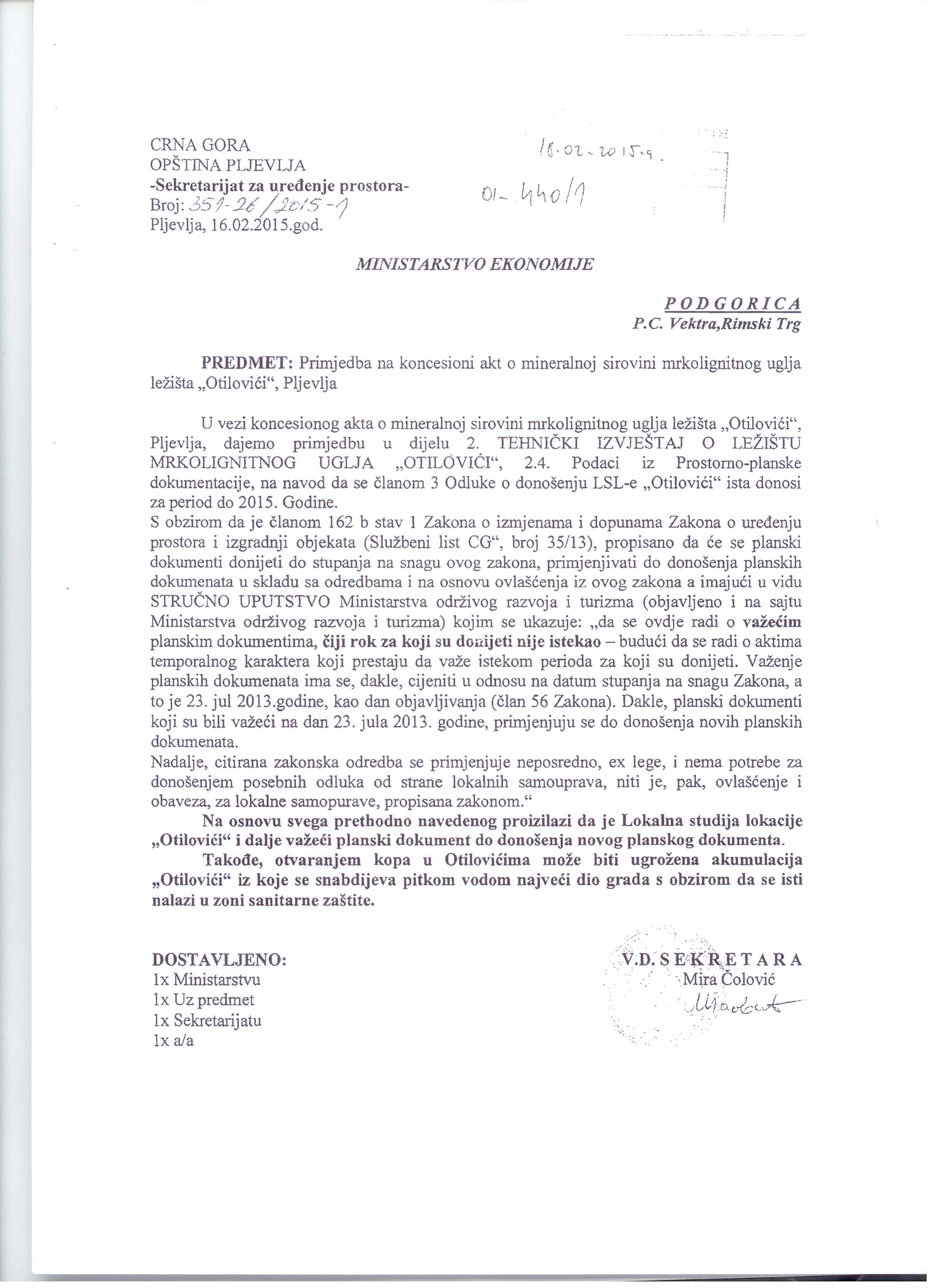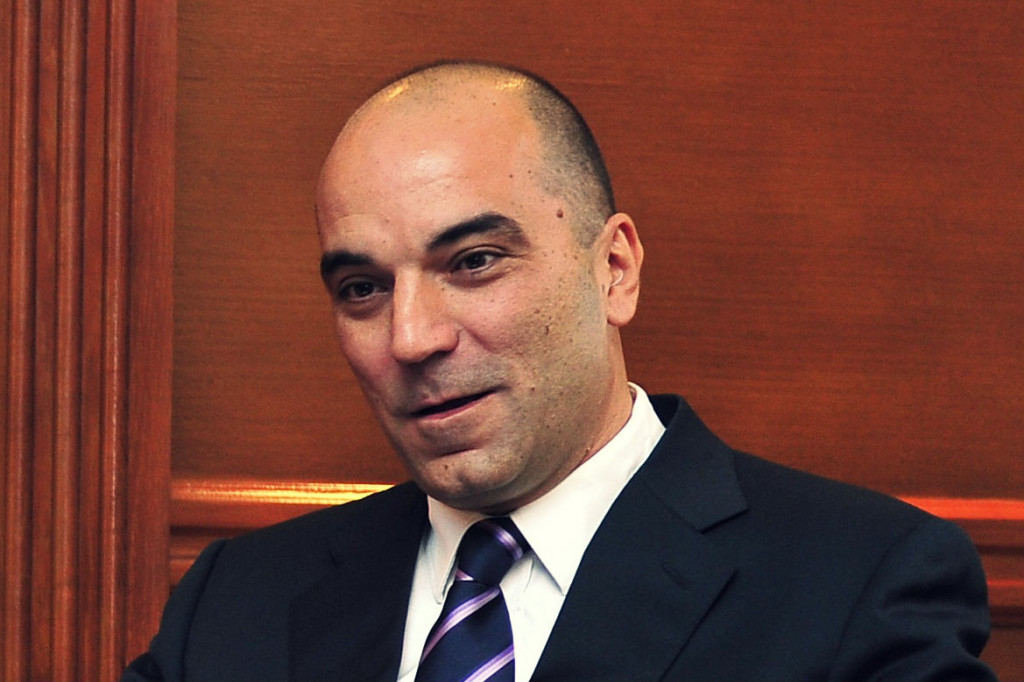The commercially viable coal reserves in the inner Pljevlja Basin are sufficient for around 20 years of operation of the second block of the Thermal Power Plant (TPP), if it is built in accordance to the offer of the Czech company Skoda Praha. This is also indicated by the studies commissioned by the Government to form the basis for the development of the Draft Detailed Spatial Plan (DSP) for the TPP.
Even in the case of mining of the deposits which the Government’s latest Energy Development Strategy identified as not viable from a commercial standpoint, data from studies indicates there would not be enough coal for 40 years of operation of the second block, which would take for the investment to become viable.
This can be concluded from the official data collected by the MANS Research Centre.
According to the Draft DSP[1], the project of construction of the second block of the TPP is based on the projection of using all coal reserves from the so-called inner Pljevlja Basin, i.e. exploitation of coal from the nine deposits located near the town area – Potrlica, Kalusici, Grevo, Rabitlje, Komini, Glisnica, Bakrenjace, Otilovici and Mataruge.
In the Draft DSP, which was subject to a public hearing in May of this year, the mineable reserves are estimated at 84 million tonnes, based on the June 2013 data by the Coal Mine from the document “Technical and Economic Analysis”.
The baseline studies for the needs of developing the Draft DSP[2] were commissioned by the Ministry of Sustainable Development and Tourism and drafted in 2013. According to the baseline studies, the mineable reserves in the nine deposits amount to 73 million tonnes, which is 11 million less than 84 million, as was indicated in the Draft.
However, four of the nine deposits planned for coal mining in the Draft DSP are commercially non-viable according to the Strategy for Energy Development until 2030[3], adopted by the Government in June of last year. These deposits are Kalusici, Grevo, Rabitlje and Komini, where coal reserves are estimated at 22 million tonnes.
The Strategy states that these deposits should not be included in the coal reserve plan forming the basis for the future production of electricity, therefore, when you subtract the reserves from non-viable deposits from the mineable reserves, which amount to 73 million, the actual commercial reserves amount to 51 million tonnes, which is significantly less than indicated in the Draft DSP.
However, given this data is from 2013, and provided that the existing first block of the TPP remains in operation until 2023 when it will have spent over 19 million tonnes of coal, it is clear that only 32 million tonnes of commercially viable coal are available for the operation of the second block.
According to the offer by Czech company Skoda Praha, the second block will annually consume 1.6 million tonnes of coal, which means that there are only enough commercially viable coal reserves for 20 years of operation. If you take into account the reserves from the economically non-viable deposits, this would be enough for 34 years of operation of the second block. The Draft DSP envisages that the second block will be in operation for 40 years.
The only alternative for providing additional coal reserves is the Maoče deposit, the opening of which would require additional costs due to the distance and large transport costs. The Book on Development of Coal, Oil and Gas Systems[4], which was published in 2006 for the needs of drafting the Energy Development Strategy by 2025, states that the coal from Pljevlja has a low calorific value, which is why it has to be used in the vicinity of deposits, because long-distance transport is not economically viable.
The Government of Montenegro insists on the construction of the second block of the Thermal Power Plant, but it has not yet published a study on the economic feasibility of the project. The Czech company Skoda Praha offered a construction price of just less than 340 million euro and its offer was chosen as the most favourable in May of this year.
The Government did not present the additional costs of the project of the second block, such as interest costs of loans, expropriation or protection of the environment and health. The EU has significantly increased the penalties imposed on CO2 emitters (TPP) and additionally augmented the environmental protection standards which have to be respected by builders of new TPP, which additionally reduced the profitability of such projects.
Authors: Ivana Gudovic and Ines Mrdovic
This article was made with the support of the European Union as part of the project “Zero Tolerance for Corruption”. The contents of this article are the exclusive responsibility of the Network for Affirmation of the NGO Sector – MANS, and the opinions contained herein cannot be considered as the opinions of the European Union in any circumstances.
Otilovići deposit poses a problem
 One of the sites the Draft DSP envisioned for mining is Otilovici, where coal reserves are estimated at three million tonnes.
One of the sites the Draft DSP envisioned for mining is Otilovici, where coal reserves are estimated at three million tonnes.
The letter of the Secretariat for Spatial Planning of the Pljevlja Municipality[5], which was submitted to the Ministry of Economy at the beginning of this year, indicates that the opening of the deposit in Otilovici might endanger the accumulation which supplies drinking water for most of the town, and that this area is in the sanitary protection zone.
Regarding the locations of commercially non-viable deposits, the Energy Development Strategy by 2025[6] states that coal from Kalusici has a low calorific value, and that this is a densely populated area which would require high expropriation costs.
Rabitlje is not favourable for surface mining; Grevo is burdened by an external landfill for mining waste, while the location of Komine is overcrowded by housing and partly by industrial facilities.
Ministry of Economy: There is enough ore; there will not be mining in Maoce
 The coal deposits of the Pljevlja Basin together with the smaller deposits located in the vicinity of the Basin have sufficient reserves and quality of coal for the operation of the second block of the TPP; this is the official position of the Ministry of Economy, headed by Vladimir Kavaric, which commented on this subject in late July.
The coal deposits of the Pljevlja Basin together with the smaller deposits located in the vicinity of the Basin have sufficient reserves and quality of coal for the operation of the second block of the TPP; this is the official position of the Ministry of Economy, headed by Vladimir Kavaric, which commented on this subject in late July.
Ministry officials did not specifically answer why the data from the documents on balance and mineable reserves is different, while claiming to have accurate data on the mineral resources.
Is there enough coal in Pljevlja to construct the second block of the Thermal Power Plant and what are the reserves, given that the documents drafted for the needs of this project contain different data both for balance and mineable reserves? The baseline studies for DSP and SEA contain data inconsistent with those from the proposed DSP, which cites the outdated Energy Development Strategy from 2006.
“The balance reserves of coal in the Municipality of Pljevlja, not counting the coal from the Maoca coal basin, amounted to 71,544,788 tonnes on December 31, 2014 with an average coal quality of 10,300 kJ/kg. The balance reserves of coal are determined by Studies on Classification, Categorisation and Calculation of Coal Reserves (which are published every five years, and are used as the basis for the issuing of certificates by the Ministry of Economy). The mineable coal reserves are determined on the basis of balance reserves and mining conditions and they are never the same as the balance reserves. The Mataruge coal deposit is not researched in detail, and the Coal Mine submitted an initiative to the Ministry for issuing of concessions for detailed geological research and coal mining for this deposit. Based on previous geological research and the drafted Report, this deposit has over 7,500,000 tonnes of coal with an average quality of around 8,000 kJ/kg, and the reserves will be verified after research and development of the Study on Reserves and Quality of Coal.”
Does the fact that you use outdated and inconsistent data mean that you do not have the exact information on the mineral resources of Pljevlja, especially having in mind that the insufficiently researched reserves are prevalent?
“The indicated reserves and quality of coal are identical to the state on December 31, 2014 and they were used as the basis for the drafting of the Energy Development Strategy. We have an accurate source of data which was stated in the answer to your first question (table overview – Recap of balance reserves of coal in the area excluding the Maoce basin, on December 31, 2014).”
What is the quality of the coal, i.e. can you guarantee it will meet the requirements of the modern technology of TPP construction, which was announced?
“The average quality of coal in the supply dynamics of block II is around 9.400 kJ/kg. This data was presented to potential investors in Block II and it satisfies all the requirements of the future Block II both in terms of quality and in terms of chemical composition”.
The documents on the second block of the TPP which were in public discussion included the deposits Rabitlje, Komini and Grevo, and they indicate these deposits contain almost 10 million tonnes of the overall indicated quantity, even though they were classified as economically non-viable. Why is that so?
“The Coal Mine has concessions for the deposits Rabitlje, Komini and Grevo and it performed detailed geological research which will provide the basis for the drafting of the updated Studies on Reserves and Quality of Coal, and previous research indicates that coal reserves in these deposits amount to around 10 million tonnes.
According to the envisioned mining dynamics, the mining in the Grevo deposit will commence after the completion of mining of surface deposit Potrlica and it practically represents the continuation of coal mining in this part of the Basin, therefore the investments on the opening of this deposit are practically non-existent aside from the operating costs including the relocation of infrastructure facilities and expropriation. The deposits Rabitlje, Komini, Bakrenjace and Ljućc II, which contain around 11 million tonnes of coal, were not intended for mining in the presented dynamics, and they practically represent “reserves” in case of additional needs.”
Will the Maoca Basin be activated in the case of a lack of ore for the second block of the TPP and under what conditions?
“After considering the thermal energy potential for the second block of the TPP and its operation by 2057, we concluded that there is no need to open surface deposit Maoce”.
Who guarantees to the future investor in the construction of the energy facility that there is enough ore for the new block, i.e. who is liable for the risk of a situation different to the displayed data, which is outdated and inconsistent?
“On the basis of all previous geological research and certified Studies on Reserves and Quality of Coal as well as certificates issued by the Ministry, the coal deposits of the Pljevlja Basin together with the smaller deposits located in the vicinity of this Basin have sufficient reserves and quality of coal for the operation of the second block of the TPP”.



